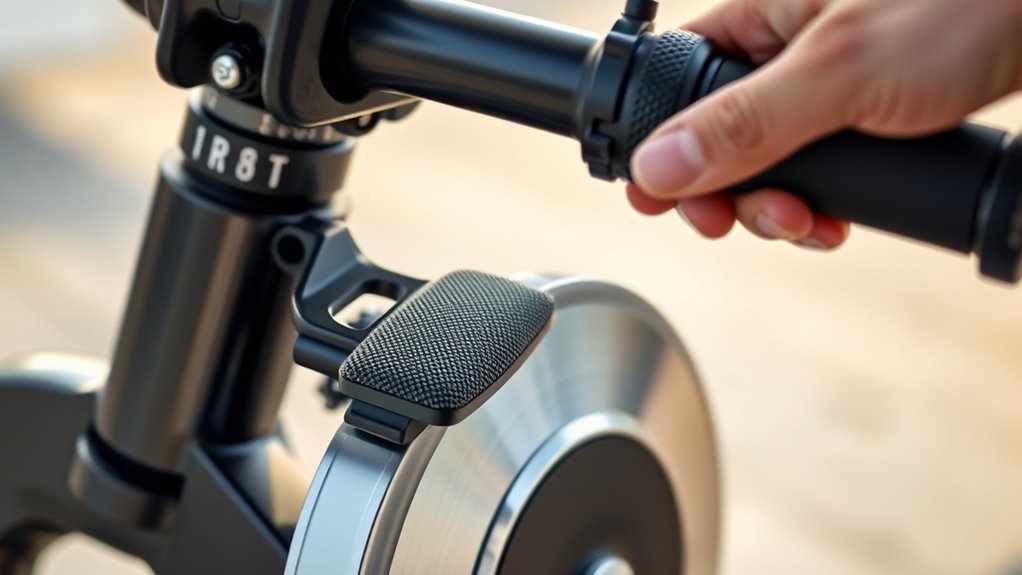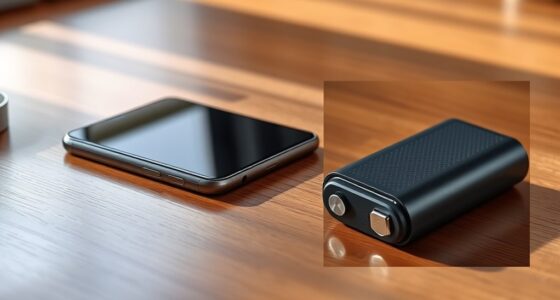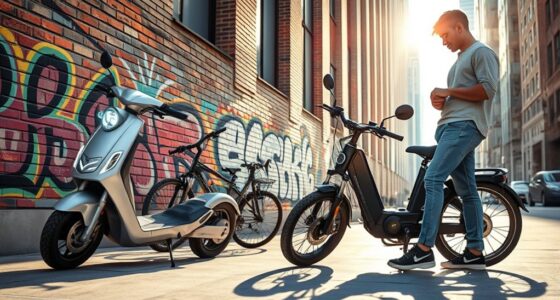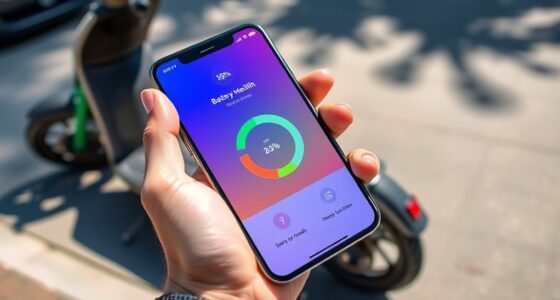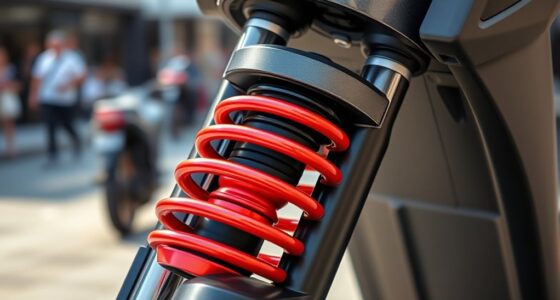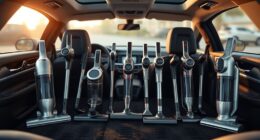To safely adjust your electric scooter’s brakes, start by inspecting the brake pads for wear and replace them if needed. Then, tighten or loosen the brake cable or hydraulic line to ensure the brake engages promptly without excessive resistance. Adjust the brake lever tension using the adjustment screw until it feels firm but responsive. Regularly clean the rotor and pads and check for any damage. For detailed steps, continue exploring tips to keep your brakes in top shape.
Key Takeaways
- Inspect brake pads regularly for wear and replace if they are thin or uneven.
- Adjust the brake lever tension using the adjustment screw for responsive and firm braking.
- Check and lubricate brake cables or hydraulic lines to ensure smooth operation.
- Clean the brake rotor and pads periodically to prevent squealing and maintain performance.
- Test brake responsiveness after adjustments to ensure safe and effective stopping power.
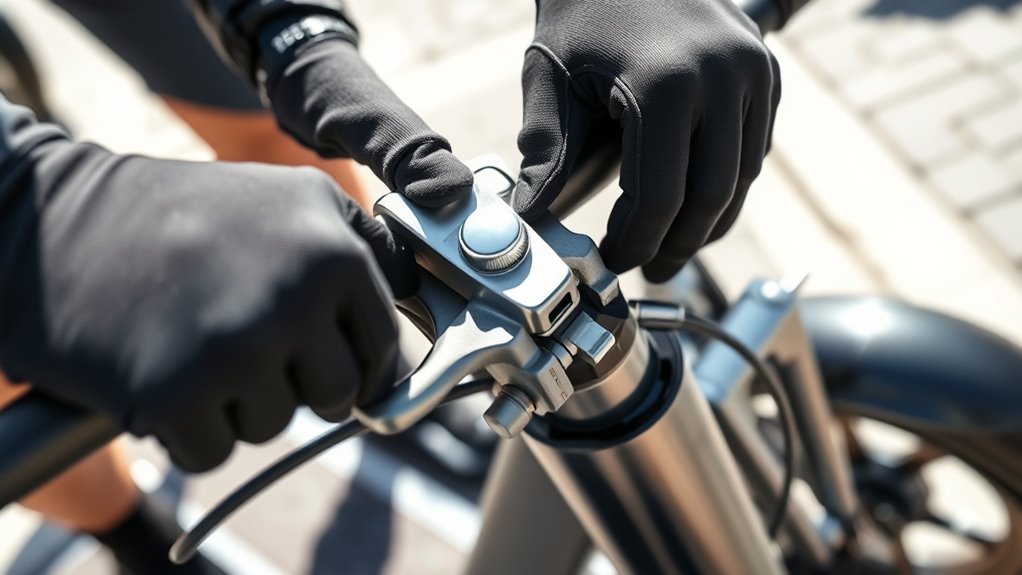
If your electric scooter’s brakes feel less responsive or squeal when you ride, it’s likely time to adjust them. Proper brake pad maintenance is essential for safety and to guarantee your scooter stops smoothly. Start by inspecting the brake pads themselves; over time, they wear down and can become uneven or too thin, reducing braking efficiency. If you notice the pads are worn past the recommended thickness, replace them to restore peak stopping power. When inspecting, check for debris or dirt lodged between the pads and the rotor, as this can cause squealing or reduced responsiveness. Cleaning the brake pads and rotor with a soft cloth or isopropyl alcohol can improve performance and extend the lifespan of your brake components.
Inspect and replace worn brake pads for safer, smoother stops and improved responsiveness.
Next, consider brake lever troubleshooting. A loose or overly tight brake lever can compromise your ability to control braking force. If your brake lever feels spongy or doesn’t engage firmly, you may need to adjust the tension. Most scooters have an adjustment screw near the lever or on the brake assembly itself. Turning this screw clockwise typically increases tension, making the brake lever feel firmer and more responsive. Conversely, loosening it can create more play if the brakes are too tight. Be cautious to find a balance where the brake engages promptly without causing excessive resistance or drag.
Once you’ve adjusted the brake lever, check the response by pulling the lever firmly and observing how the brake engages. If it still feels unresponsive, check the brake cable or hydraulic line for any kinks, leaks, or damage. For cable-operated brakes, ensure the cable isn’t frayed or stretched and that it moves freely within its housing. Lubricating the cable with a suitable lubricant can also improve responsiveness. Hydraulic brakes require checking the fluid levels; if fluid is low or contaminated, bleeding the brakes might be necessary to restore proper function. Additionally, the contrast ratio of your brake system can influence how well you perceive the difference between stopping and moving, especially in varying lighting conditions.
Throughout this process, remember that proper brake pad maintenance, coupled with troubleshooting your brake lever, is key to safe riding. Regularly inspecting and adjusting your brakes ensures that they perform reliably when you need them most. If, after these adjustments, your brakes still feel off, consider consulting a professional or replacing worn components to guarantee your scooter remains safe and responsive on every ride.
Frequently Asked Questions
How Often Should I Check My Scooter’S Brake Adjustments?
You should check your electric scooter’s brake adjustments regularly, ideally every month or after rough rides. During these checks, inspect brake pad wear and verify brake fluid levels are adequate if your scooter uses hydraulic brakes. If you notice squeaking, reduced responsiveness, or uneven pad wear, it’s time to adjust or replace parts. Keeping an eye on these factors helps maintain safe braking performance and prolongs your scooter’s lifespan.
Can I Adjust the Brakes Myself or Need Professional Help?
Thinking about DIY maintenance for your scooter’s brakes is like trying to tame a wild horse—you can do it, but caution’s key. You can usually adjust your brakes yourself if you follow the manufacturer’s instructions carefully. However, if you’re unsure or the brakes are complex, seeking professional assistance guarantees safety and proper function. When in doubt, it’s better to be safe than sorry—know your limits and don’t hesitate to get expert help.
What Tools Are Needed to Adjust Electric Scooter Brakes?
To adjust your electric scooter’s brakes, you’ll need basic tools like a Allen wrench or screwdriver. These tools help you tighten or loosen brake pad replacement and fine-tune the brake system troubleshooting process. Make sure you have a wrench compatible with your scooter’s brake calipers. Properly adjusting the brakes improves safety and performance, so gather these tools before you start, and follow your scooter’s manual for specific instructions.
How Do I Know if My Brakes Are Too Tight or Too Loose?
You’ll know your brakes are too tight if you hear brake noise or feel drag when riding, which slows you down. If they’re too loose, the brake lever will feel slack, and braking responsiveness drops, making stops less effective. To find the right balance, test your brakes by riding gently, ensuring they engage smoothly without noise or excessive slack. Adjust them until they respond promptly without squeaking or feeling loose.
Are There Different Brake Types Requiring Specific Adjustments?
Picture your scooter’s brakes like different musical instruments, each needing a unique tune. Brake pad types vary—disc, drum, or V-brakes—each requiring specific adjustment procedures. For disc brakes, you tighten the caliper; for drum, adjust the internal shoes; V-brakes need you to align and tighten the cable. Knowing your brake type helps you fine-tune them correctly, ensuring smooth, safe stops every time you ride.
Conclusion
By ensuring your electric scooter’s brakes are properly adjusted, you markedly boost your safety and riding confidence. Regularly checking and tweaking the brake system can reduce stopping distances by up to 30%, helping you avoid accidents and enjoy smoother rides. Remember, well-maintained brakes aren’t just about safety—they’re about peace of mind on every journey. So, take a few minutes to adjust your brakes today and ride confidently tomorrow!
